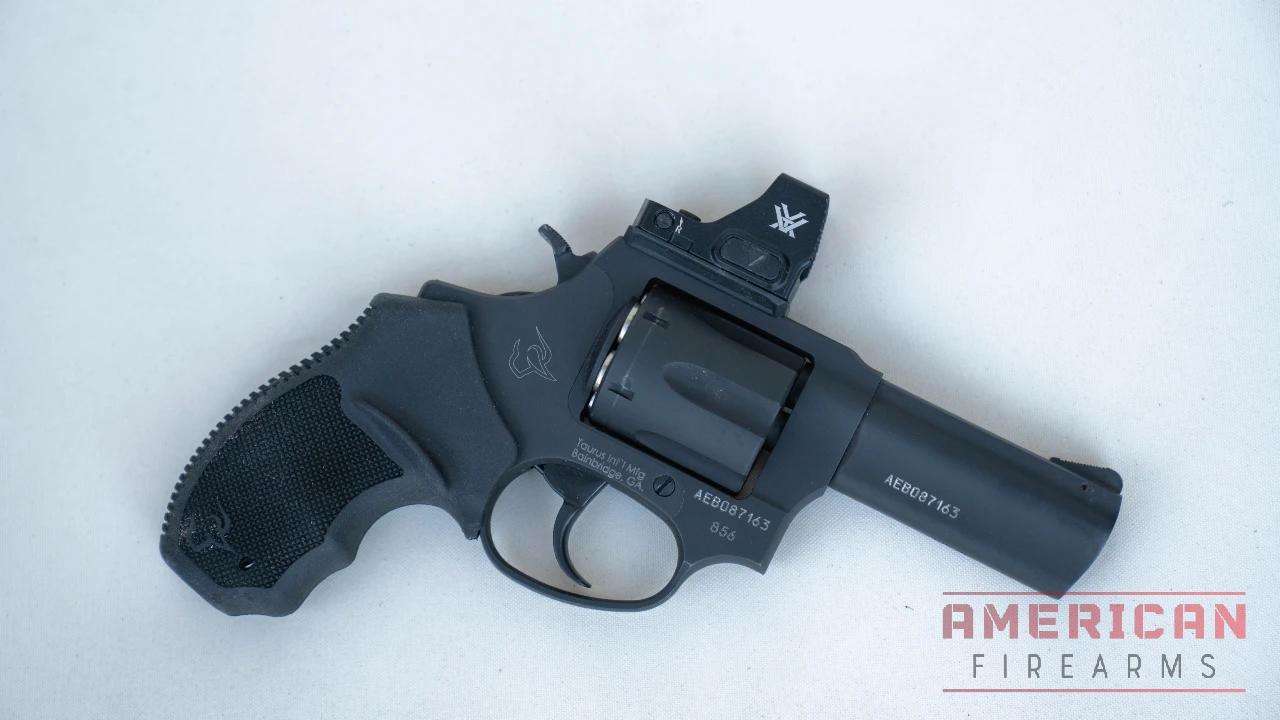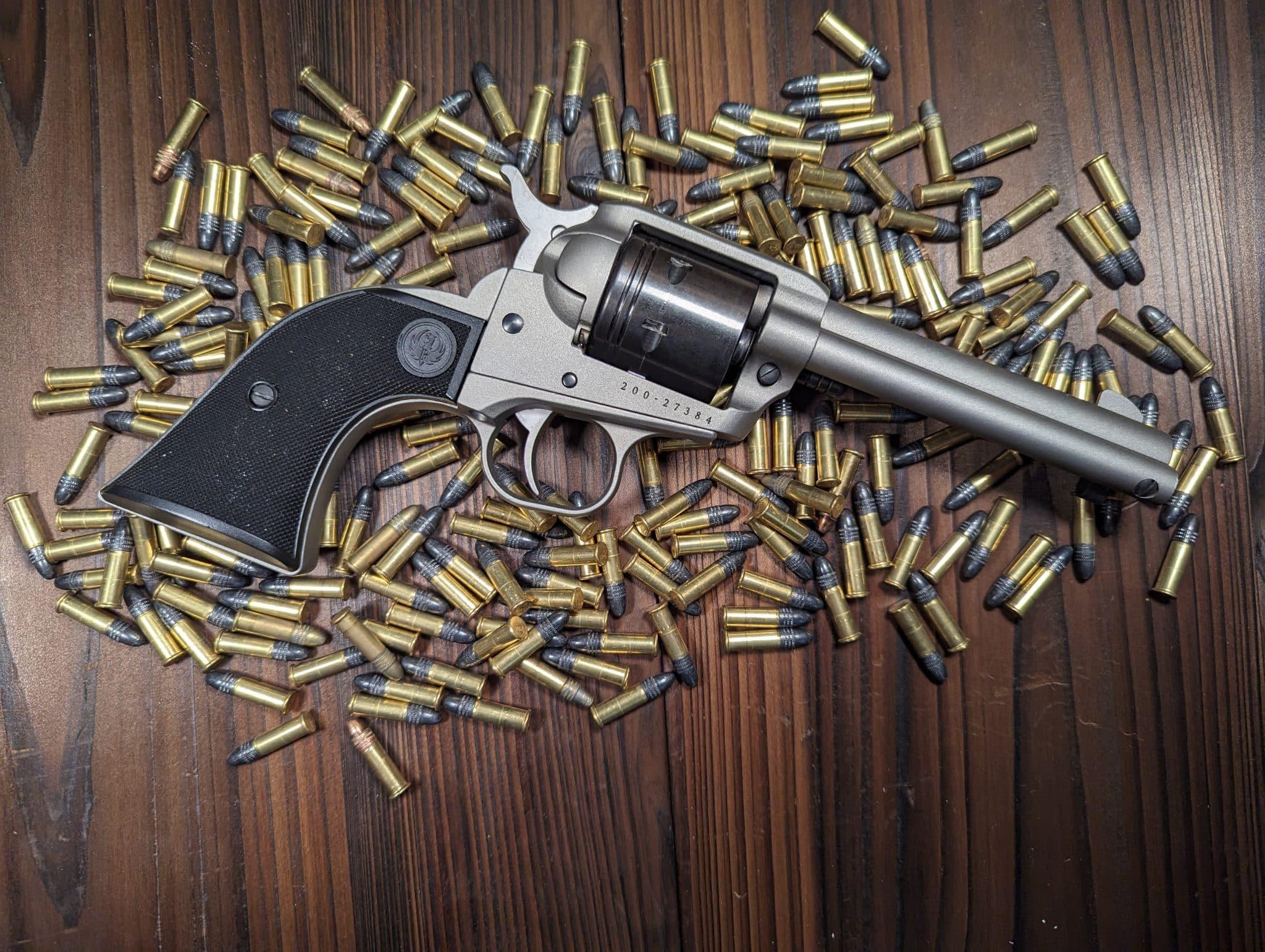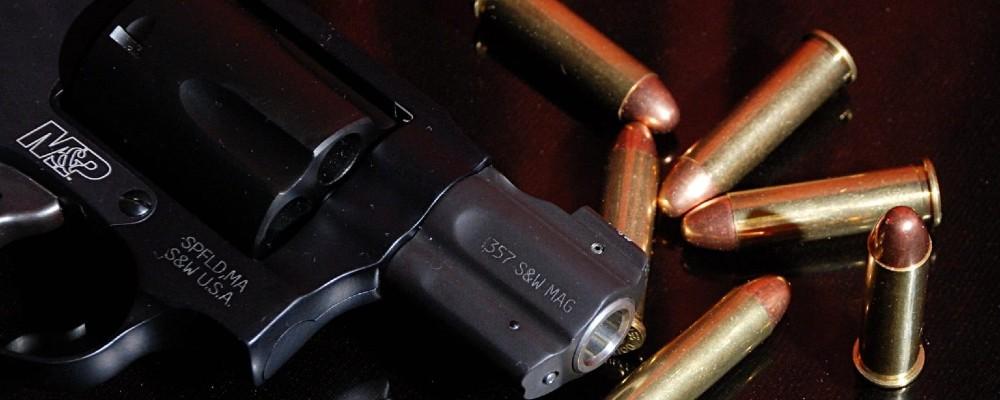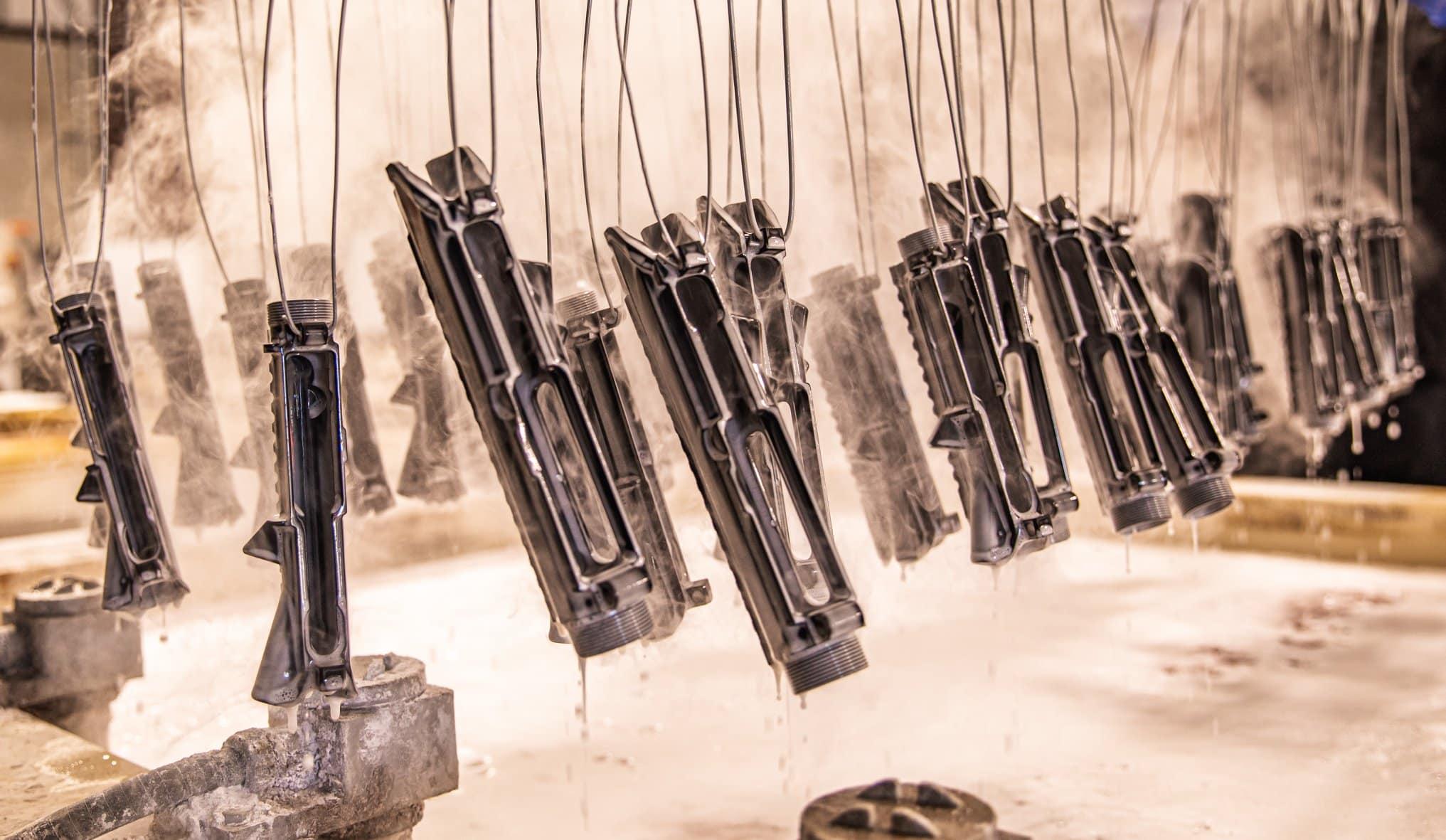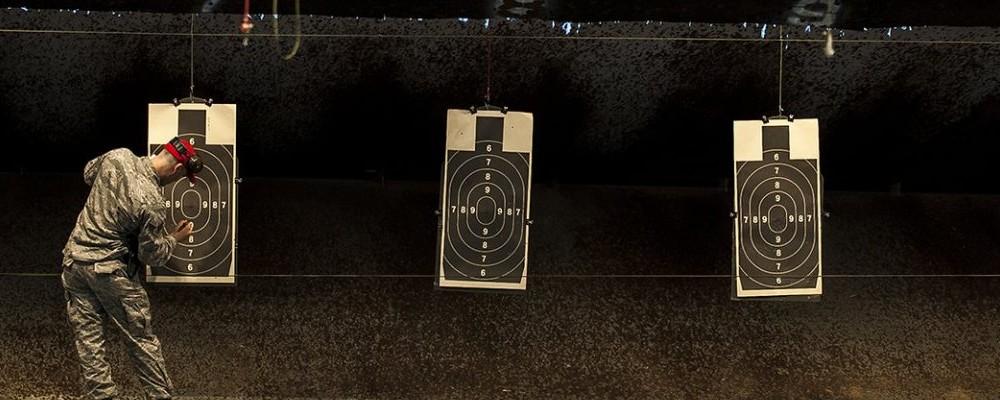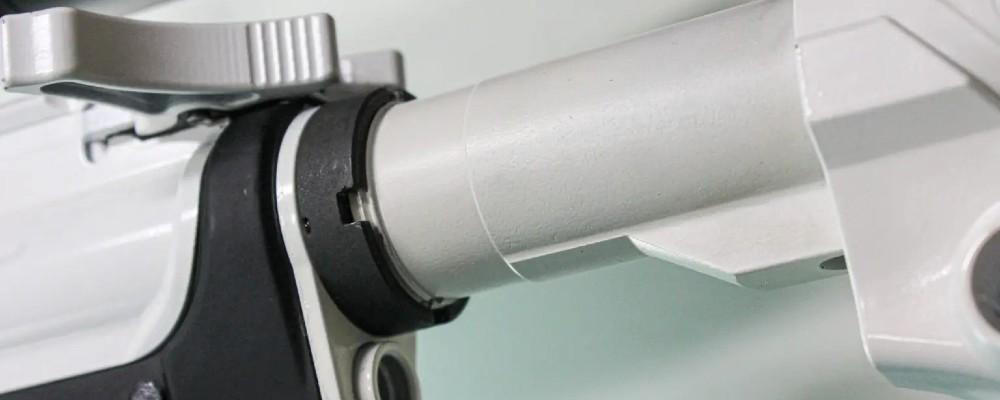A Firearms Glossary
Written By
Michael Crites
Licensed Concealed Carry Holder
Reviewed by
Editorial Team
Learn About The Editorial Team
Share:
Products are selected by our editors. We may earn a commission on purchases from a link. How we select gear.
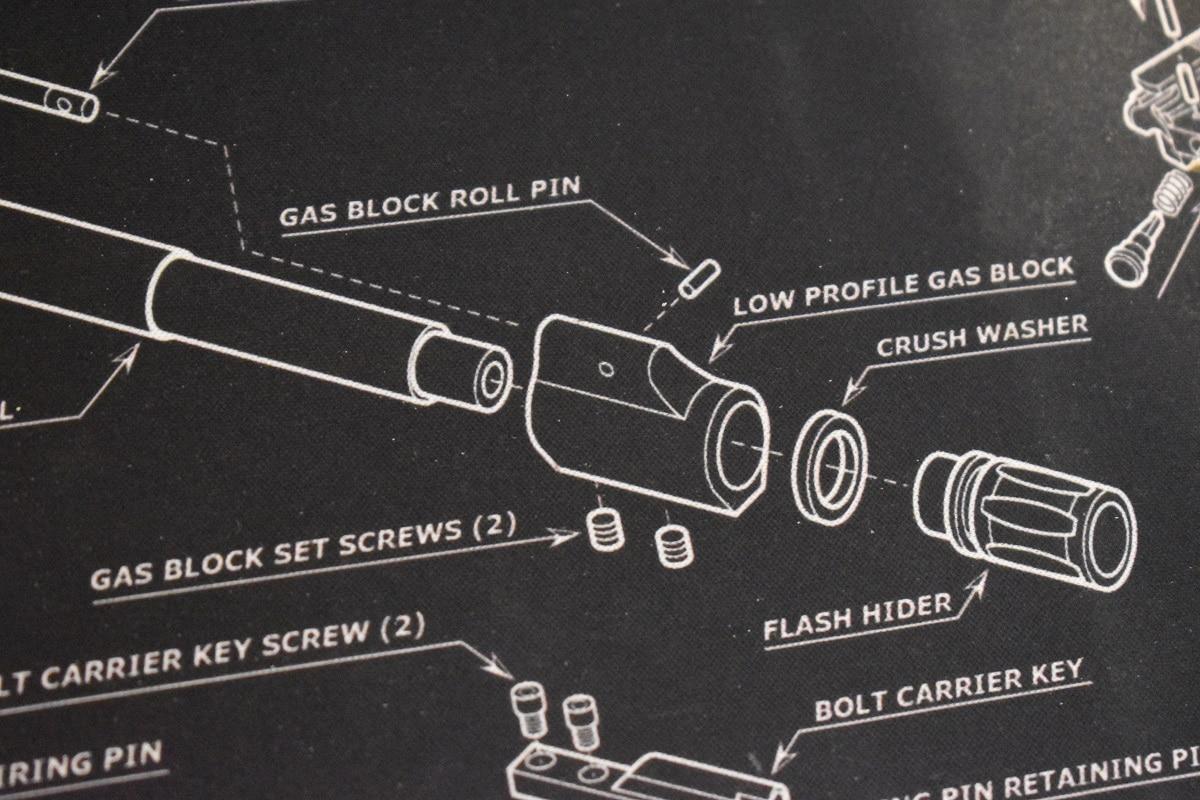
Updated
Jan 2023
References to firearm condition standards are those that have been established by the National Rifle Association regarding the physical status of antique weapons
ACP: Abbreviation for automatic colt pistol.
Action: A firearm’s working mechanism (typically the receiver or frame and breech bolt) that facilitates its firing and loading/unloading. There are a variety of types of actions from single to automatic.
Action Shooting: A competitive event where participants draw holstered pistols and fire at various-shaped, small targets. The winner is the most accurate shooter or fastest shooter.
Air-gun: Refers to any gun that fires projectiles (BBs, pellets) by C02 or compressed air.
Ammo: Abbreviated form of ammunition.
Ammunition: A complete assembly consisting of a case, a charge (gunpowder), and a projectile. Also known as fixed ammunition.
Antique: Refers to any firearm, made before 1899, that is not designed to fire fixed ammunition or for which ammunition is unavailable.
Armor-Piercing Ammunition: The U.S. Government defines it as projectiles that are used in handguns and which consist (entirely or primarily) of beryllium copper, brass, bronze, depleted uranium, iron, steel or tungsten alloys.
Arsenal: A government facility that makes, repairs and, stores ammunition and firearms.
Artillery: Typically refers to firearms with bore diameters of 3 or more inches. Generally they fire explosive projectiles and must be operated by a crew.
Assault Rifle: A selective-fire rifle designed to rapidly fire intermediate power cartridges through selective and automatic fire. This type of firearm originated in early 1940s Germany. Their “storm rifle” was made to spray bullets to maximize the weapon’s ability to wound and kill during combat.
Assault Weapon: Technically any weapon used in an assault, but usually refers to firearms that are compatible for efficient attacks. See “Weapon.”
AFTE: The Association of Firearms and Tool Mark Examiners
Auto(matic) LoadingSee “Semi-Automatic.”
Automatic: Firearm that continuously feeds cartridges, fires their bullets and ejects their empty cases.
Automatic Pistol: Popular term that is a misnomer. See “Semi-Automatic Pistol.”
Backstrap: The part of a pistol that is exposed at the rear of the grip.
Ball: Typically refers to a cylinder-shaped bullet with either a rounded or pointed nose and is typically used with muzzle-loaded firearms.
Ballistics: The study of projectile motion and effects. In the case of guns, it refers to all factors that affect the bullet, including the velocity, trajectory, size of load, rifling, and more. Each weapon has its own unique “ballistic signature,” which leaves markings on the bullets. This allows police laboratories to determine whether two bullets were fired from the same weapon.
Barrel: The rifled or smooth tube that a projectile travels after it’s been fired.
Barrel Band: A fixed or adjustable band that holds a gun’s barrel and stock together.
Barrel liner: A liner made of special material that is inserted into a bore to either protect the bore, correct bore erosion or alter the bore so that it can fire smaller caliber ammo.
Barrel Locks: Devices inserted into a firearm’s barrel or through the barrel and chamber to prevent discharge.
Barrel Selector: Component that determines the firing order in a double-barrel gun.
Base Wad: A paper filling that is found in the shotgun shell’s powder charge.
Battery: The flintlock component that, when struck, creates sparks that ignites the powder. Also references a cartridge in firing position after recovery from the recoil of a previous discharge.
Bayonet Lug: A mounting on a firearm for attaching a bayonet or accessory.
Bedding: The point to which a firearm’s barrel is fitted.
Beavertail Forend: A wide-styled forend.
Benchrest (Shooting): A competition where participants fire from a fixed shooting position in an attempt to place consecutive shots into the smallest possible grouping on a paper target. Typically it involves groups of at least 10 shots and at different target distances.
Berdan Primer: See “Primer.”
Bird Shot: Refers to shotgun projectiles that have a diameter less than .24″.
Blackpowder: The earliest form of firearm propellant. Except for its use in antique guns, it has been replaced by higher pressure, smokeless powder.
Blank Cartridge: A cartridge containing a charge but no projectile. It is used for starter’s guns or for special uses such as in movies or theatre productions.
Blind box magazine A magazine that is inserted into a firearm handle and has a permanent closed bottom.
Bluing A gun’s blue or black metal finish that is the result of an acid bath. The coloration and protectant applied to barrels and other exposed metal parts on guns.
Brass The generic term for spent cartridges, even though they’re often made of bronze or aluminum. Commonly used in the context of “pick up your brass after you shoot.”
Breaking: Some shotguns are designed with a hinge that lets the barrel pivot away from the stock so that you can slide in a shell. Opening it this was is called “breaking” the gun.
Boat-tail: A bullet with a tapered end to improve its long-range efficiency.
Body Armor: Vest type jacket worn by law enforcement or military personnel. It is usually made of light-weight, bullet resistive material such as Kevlar.
Bolt-Action: A firearm with an assembly that requires a user to manually lock a cartridge into firing position in its barrel or chamber.
Bore: The interior of a firearm’s barrel excluding the chamber. The hole through the center of the barrel, through which the bullet travels. The bore may be smooth (shotguns and muskets) or rifled (rifles and handguns).
Box magazine: An ammunition holder where the cartridges are vertically stacked.
Brass: A slang term for a spent case. It’s used because a case is most commonly made out of brass.
Breech: The rear part of a gun’s bore.
Breechblock: A movable piece of metal used to open and close a gun’s breech.
Buck Shot: Refers to shotgun projectiles that have a diameter 24″ or greater.
Buckhorn Sight: An open, metallic rear sight with sides that curl similarly to a buck’s horns.
Bull Barrel: A heavier, thicker than normal barrel with little or no taper.
Bullet: The projectile expelled from a gun, which is distinct from a cartridge. Bullets come in a variety of types and are usually composed of lead or lead that is shielded with a harder metal.
Bullet-Proof Jacket or Vest: A misnomer. See “Body Armor.”
Butt: Describes the bottom part of a pistol grip and the rear or shoulder portion of a rifle or shotgun.
Butt plate: A covering that protects the butt of a firearm. The cover may be metal, plastic, rubber or some other material.
Caliber: The diameter of a projectile for a rifled firearm or the interior diameter of a rifled barrel. In the U.S., the diameter is expressed in hundreds of an inch.
Calibre: See “Caliber.”
Cannelure: A groove around a projectile’s circumference.
Carbine: This name applies to any short-barreled rifle (designed for easier use and concealment).
Cartridge: A single, complete round of ammunition consisting of a case, charge (propellant) and projectile (bullet).
Case, Casing: The material that surrounds and holds the charge (cartridge propellant) and/or projectile. It is typically made of brass.
Caseless Ammunition: Ammo that includes a propellant charge in its base rather than in a separate case.
Center-Fire: A cartridge with a primer placed at the center of its casing’s base.
ChamberThe area of a firearm that holds a cartridge immediately prior to its being fired.
Charcoal Color CasehardeningA method of strengthening gun metal by subjecting it to high heat and plunging it into cold water.
Charging HandleA handle that cycles a semi or fully automatic firearm without discharging.
CheckeringThe diamond-shaped tool patterns that are cut into firearm grips.
Cheek PieceA raised portion on the side of the gun’s stock where a user rests his or her cheek while operating a gun.
ChokeA constriction at or near a shotgun muzzle. It is designed to control shot dispersion.
ClipPopularly refers to a container that holds a group of cartridges, which may either be transferred or inserted into a firearm.
CockThe hammer-like device on early firearms that set the weapon into firing position.
Cocking (a gun)Pulling back a gun’s hammer into its firing position.
Cocking HandleSee “Charging Handle.”
CombThe portion of the stock where a shooter rests his or her cheek.
Combination GunTypically refers to a shotgun-style base, supporting both a rifle and a shotgun barrel and capable of using several different calibers of ammo.
CompensatorSee “Muzzle Brake.”
Cop-Killer BulletAn inflammatory phrase typically used to refer to ammunition capable of piercing body armor (bullet-proof jackets).
CraneA U-shaped yoke that supports and facilitates the operation of a cylinder.
CrimpThe part of a shotgun shell that’s bent in to hold the shot in place.
CrosshairsThe sighting lines in a telescopic sight.
CrowningThe process of rounding and countersinking a barrel muzzle.
CylinderA drum-shaped component of a revolver that houses its ammunition.
DamasceneDecorating one metal by inlaying or attaching another metal.
Damascus BarrelA barrel made by welding thin strips of metal that have been twisted around a metal rod (called a mandrel).
DampenersAn accessory, usually added to a rifle’s stock, to absorb the shock of recoil.
DerringerA very short-barreled (one or two shot) pocket pistol named after its inventor, Henry Derringer.
DeterrentA material used with gun powder to slow its burn rate.
DetonateTo ignite (initiate) an explosive device.
DischargeTo fire a weapon.
DispersionTravel pattern of bullets fired from a single source.
Double-ActionA firearm that is fired either by manually cocking the weapon and then pulling the trigger or by using trigger action to both cock and fire the weapon.
Double-barreled ShotgunA shotgun with two separate barrels allowing for two discharges before reloading.
Double-Set TriggerA device consisting of one trigger which cocks and gun while the partner fires it.
DramOne sixteenth of an ounce (or 1/256 of a pound, or 27.34375 grains).
Dram equivalentA method for describing the power of a shotgun shell by equating its load of modern smokeless power with an equivalent load of black powder, in drams.
DrillingA German term referring to a gun with three-barrels.
Drum magazineRefers to an ammunition holder where cartridges are stored in a circular fashion.
Dry FiringDischarging an unloaded firearm in order to become familiar with its operation.
DudA popular term for a cartridge that fails to fire after its primer is struck by the firearm’s firing pin. See “Hangfire.”
Dum-Dum BulletA lead-core, shielded bullet with an open nose that was developed by the British in the late 19th Century. It was outlawed by the 1899 Hague Convention.
English StockA straight rifle stock with a slender grip.
EjectorA mechanism that throws cases free of a firearm.
Excellent(NRA Condition Standard) all original parts: over 80% original finish: sharp lettering, numeral and design on metal and wood: unmarred wood: fine bore.
Expanding BulletAny bullet that is designed to expand upon striking. This action increases the bullet’s stopping power (and lethality).
Expert MarksmanA highly-skilled shooter, capable of hitting any target falling within weapon range.
Exploding BulletA bullet with an explosive component that explodes under striking (ironically this feature severely reduces its ability to penetrate a target).
ExtractorA device that pulls (hooks) spent cases out of a chamber.
Extrinsic SafetyAn external component that is attached to a gun to avoid unintended discharge, such as a separate trigger lock.
Factory New(NRA Condition Standard) all original parts: 100% original finish: in perfect condition in every respect, inside and out.
Fair(NRA Condition Standard) some major parts replaced; minor replacement parts may be required; metal rusted, may be lightly pitted all over, vigorously cleaned or reblued; rounded edges of metal and wood; principal lettering, numerals and design on metal partly obliterated; wood scratched, bruised, cracked or repaired where broken; in fair working order or can be easily repaired and placed in working order.
FeedTo move a live cartridge from a firearm’s magazine to its chamber.
Field LoadA shot shell load designed for hunting small bird and game.
Fine(NRA Condition Standard) all original parts: over 30% original finish: sharp lettering and numerals on metal and wood, minor marring on wood, good bore.
FirearmTechnically, any pistol, rifle, or shotgun that uses gunpowder to launch projectiles.
FirepowerA generic reference to how heavily or seriously armed a party is.
Firing PinThe breech component that strikes the primer, igniting the cartridge.
Fit And FinishRefers to a firearm’s over-all workmanship.
Fixed AmmunitionSee “Ammunition.”
FlashThe light emitted from a weapon’s muzzle when it is discharged.
Flash Hider/Flash SuppressorAn accessory that is attached to a muzzle. It is designed to minimize any visible muzzle flash during discharge.
FlintlockAn antique gun which has a firing mechanism consisting of flint striking steel to create sparks that ignites a primer.
Floor PlateThe bottom plate of a cartridge magazine that’s removable.
Floating BarrelA barrel bedded to avoid contact with a gun’s stock.
FMJSee “Full Metal Jacket.”
Foot-poundUnit of measure of kinetic energy of a bullet.
Forcing ConeThe tapered front section of a revolver or shotgun chamber that reduces in size to match the barrel’s bore (diameter).
ForearmThe potion of a stock located under a firearm’s barrel.
Fore EndSee “Forend.”
ForendThe front portion of a rifle or shotgun stock.
F.P.S.Feet per second (in regards to projectile speed)
FrameSee “Receiver.”
Frangible bulletA projectile designed to minimize ricochets by disintegrating when a hard surface is struck.
Free RifleA rifle, having to weigh less than 17.6 pounds, that is designed for international-type target shooting.
Front StrapThe forward facing portion of a pistol or revolver that is joined with the trigger guard.
Full chokeA tight constriction in the muzzle of a shotgun, producing a long range and tight pattern.
Full Metal JacketA bullet that is fully encased with a layer of hard metal jacket which maximizes its ability to penetrate a target.
Gain TwistA barrel with an increasing pitch in its rifle grooves, resulting in an accelerated bullet spin.
Gas-operatedAn automatic or semi-automatic firearm that uses propellant gases to operate its case ejections.
GaugeRefers to a shotgun barrels bore size. The larger the number the smaller the bore. The gauge actually describes the number of lead balls the diameter of the bore that it would take to make a pound (e.g., a lead ball that would exactly fit the barrel of a 20-gauge shotgun would weigh 1/20 pound).
Geneva Convention(s)A set of international agreements regarding the behavior of warring nations. It is frequently noted for its ban on the use of ammunition designed to expand upon impact.
Ghost Ring SightA sight with a large opening and a thin rim that is positioned on the rear of a rifle or a shotgun. It is used in conjunction with a front-mounted sight and results in the ability to quickly find a target.
Good(NRA Condition Standard) some minor replacement parts; metal smoothly rusted or slightly pitted in places, cleaned or reblued (metal re-colored); principal lettering, numerals and design on metal legible; wood refinished. Scratched, bruised, or minor cracks repaired; in good working order.
GrainA unit of measure used for bullets or powder. One grain is equal to 1/7000 pound; equals a troy gain or 64.799 milligrams. A grain is not the same as a “granule” or piece of powder.
GripThe part of the gun’s handle held by the hand that works the trigger.
Grip SafetyA locking device located on the grip, which unless depressed, prevents a discharge.
GroovesSee “Rifling.”
GunIn the U.S., term may be applied to airguns, cannons, pistols, rifles and shotguns.
Gun ControlTypically refers to either existing or proposed laws involving firearm sales and ownership.
GunneryThe art/practice of building and operating large bore guns.
Gun LockThe firearm mechanism responsible for exploding the primer (charge).
Gun PowderAny powdered substance that can be ignited and is suited for propelling projectiles.
Gun SafeSee “Lock Box.”
Gun SmithA person skilled in making and repairing guns.
HammerThe firearm component that causes the firing pin to ignite a cartridge primer.
Hammer blockA safety device that separates the hammer from the firing pin until discharged.
HammerlessA firearm with a frame design that conceals its firing pin and hammer.
HandgunSee “Pistol.”
HangfireA cartridge that has a delayed discharge due either to defective primer or a defective blow from a firing pin.
HeadSee “Base.”
HeelThe base of a bullet or firearm stock.
High-Capacity MagazineAn informal reference to a magazine holding a high number of cartridges.
High IntensityProjectiles that fire at a very high velocity, resulting in longer range shots.
Hinged Frame ActionA firearm design where the action may be opened to pivot down, sideways or up to allow for loading and unloading.
Hollow-Point BulletA bullet with a concave nose that maximizes its ability to expand after it penetrates a target.
HoplophobeA fairly recently coined term for persons with an irrational fear of weapons. Apparently pejorative, it comes from the Greek words for tool or weapon and fear.
HPAbbreviation for a hollow point bullet.
Igniting ChargeSee “Primer.”
Improved cylinder chokeA minimal amount of barrel constriction that permits a wide shot pattern.
International BallisticsSee “Ballistics.”
Intrinsic Safety DeviceAny permanently installed firearm component that is designed to minimize the chance of an unintended discharge.
Iron SightsA non-telescopic firearm sight.
JacketA layer of material, metal or synthetic, which encloses the (typically lead) core of a bullet.
JHPAbbreviation for a (Jacketed) Hollowpoint bullet.
JSPAbbreviation for a Jacketed Soft Point bullet.
JumpRefers to the change in bore diameter as a bullet travels from a chamber to the muzzle.
Kentucky RifleA type of flintlock firearm, characterized by a short stock and a long barrel.
KevlarA lightweight bullet resistive material.
Kevlar VestSee “Body armor.”
KeyholeThe elongated hole caused when an unstable projectile strikes a target sideways.
KickSee “Recoil.”
Laminated StockA warp-resistant stock that is made layers of wood that have been glued together under pressure.
Land And Groove ImpressionThe rifling marks left on a discharged bullet.
LandsSee “Rifling.”
Lead(Pronounced with a long “e”) Aiming in front of a moving target to compensate for the distance it will travel while the bullet or shot are on the way.
LeadingRemnants in a firearm bore that is left by fired bullets.
Lever-ActionA gun mechanism that is operated (loaded, fired, unloaded) by a lever, typically located below the receiver.
LoadedA firearm with a cartridge in its firing chamber.
Loading GateA hinged or spring loaded cover that, when opened, allows a firearm to be loaded or inloaded.
Loading PortA receiver opening that facilitates a cartridge.
LockTypically refers to securing the bolt of a firearm before firing it.Lock BoxA heavy, metal storage box with either a key or combination lock that is used for a pistol, ammunition and accessories storage.
Locking LugsFirearm bolt projections that fit into a receiver so that, when the bolt is closed, the action is locked into firing position.
L.R.Abbreviation for long rifle.
Machine PistolSee “Submachine Gun.”
Machine GunA rifled firearm capable of automatically feeding, firing and ejecting high-powered cartridges. Typically only military ownership and use is permitted.
MagazineRefers to either a permanent or detachable, spring-loaded container for cartridges. It is often considered the same as a clip. One distinction is that, externally, a magazine appears to complete the firearm’s form, while a clip is an ammunition insert (or transfer device) that does not affect external appearance.
Magazine DisconnectorSee “Magazine safety.”
Magazine FloorplateThe bottom of a fixed magazine.
Magazine FollowerA spring-actuated device to push cartridges in a magazine to the feeding position.
Magazine ReleaseA device that retains or releases a detachable magazine in a firearm.
Magazine SafetyA device that prevents a pistol from firing without a magazine from being fully inserted.
Magazine WellThe opening in a firearm that receives the detachable magazine.
MagnumRefers to a gun designed to fire heavy-load metal cartridges or shells.
MainspringA strong spring – an energy storage device that operates the striker or hammer of a firearm.
Mannlicher StockA slender forend that extends to the muzzle.
MatchA treated cord (cotton or hemp) used for ignition in matchlock firearms.
MatchlockAn early firearm with a firing mechanism that held a smoldering treated cord (match), which would burn until it reached a barrel opening (touch hole), explode the powder, discharging a bullet.
Metallic SightA firearm sight to aid a user’s aim but is not telescopic.
Micrometer SightA sight that is finely adjustable.
Military FirearmAn informal term, generally implying a pistol with accessories that is suited for military rather than civilian use.
MisfireWhen cartridge fails to fire due to it or a firearm being defective.
Monte Carlo StockA stock with an elevated comb that is typically used with rifles equipped with telescopic sights.
MouthA cartridge’s open end that accepts a bullet.
Multi-BarreledA gun with more than one barrel (ex. double-barreled shotgun or derringer).
Mushroomed BulletDescribes a bullet’s nose which has expanded after striking a target.
MusketA long-barreled, flared end firearm with a smooth bore. It was a single-shot weapon, loaded through its muzzle.
MusketoonA musket with a modified barrel for use by soldiers on horseback.
MuzzleA barrel’s open end that is a projectile’s exit.
Muzzle BrakeA muzzle with an accessory or a modification that acts to control gas expansion, which in turn, reduces the amount of gun recoil.
MuzzleloaderThe earliest fore-runner of modern firearms. Such guns require powder and projectiles to be separately loaded through either the muzzle or, with revolvers, through cylinder chambers.
National Firearms Act of 1934Federal act that regulates firearm ownership and sales and registration of certain classes of firearms.
Negligent DischargeA term that is used to refer to unintended discharge of a firearm that causes bodily injury, property damage, etc. Gun advocates and proponents debate whether it should be synonymous with accidental discharge.
Needle GunAn early rifle that was first fired using a bolt action.
NippleThe area of a firearm where flame accesses and ignites a cartridge’s powder charge.
NoseThe forward point of a bullet.
NRA (National Rifle Association)This organization is an advocate of the public’s right to own guns, provides training related to safe gun use, and sponsors firearm competitions on a national basis.
OgiveThe curved nose of a missile, rocket or projectile.
Open SightA commonly used sight that is located at the rear of pistols rifles and shotguns and has an open notch at its top.
Operating HandleSee “Charging Handle.”
Optical SightGeneric reference for laser and telescopic sights.
Out Of BatteryDescribes a breeching mechanism that is properly aligned for firing.
OvershootSee “Spray.”
Over-underA two-barrel gun in which the barrels are vertically stacked.
PanA small side-mounted container found in early firearms, which held priming powder.
ParabellumThe word is a word coined by German arms maker Deutsche Waffen und Munitionsfabriken and is derived from the Latin saying “si vis pacem, para bellum,” meaning “If you want peace, Prepare for war.”
ParkerizingA gray or green, rust-resistant matted finish used on military guns.
Partition BulletA two-chambered, jacketed bullet. The front portion expands on impact and the rear piece remains intact to ensure penetration.
PatchRefers either to cloth used to clean a gun’s bore or a piece of leather or cloth that is wrapped around a bullet (round ball) before a ram rod is used to load it into a muzzle-loaded gun.
Patch BoxA covered compartment in the butt stock of a muzzle-loading rifle that stores, primarily, patches.
PelletsSmall round projectiles loaded in cartridge shells and/or the skirted projectiles used in pellet guns.
Pellet GunA rifle or pistol that fires pellets using compressed air or CO2.
Pennsylvania RifleSee “Kentucky Rifle.”
PepperroxEarly form of a repeating pistol consisting of several barrels bored in a circle in a metal cylinder.
Percussion CapA small metal explosive-filled cup that is placed over the nipple of a percussion firearm.
Percussion LockAn early firearm, such as a flintlock, which is operated via a gunlock that strikes a percussion cap.
Personalized GunA pistol that has been specially customized so that it may only be fired by an authorized user. A magnetic or electronic system is used so that only the authorized person can release the firing mechanism.
PistolAny variety of gun, including revolvers, which may be readily held and fired in one hand.
Pistol GripThe protrusion on the handgun, or on the buttstock or front portion of a shoulder-operated gun, that allows the weapon to be comfortably held by a hand.
PlinkingDescribes the very common practice of firing at various inanimate targets such as cans, bottles, etc.
Poor (NRA Condition Standard)Major and minor parts replaced; major replacement parts required and extensive restoration needed; metal deeply pitted; principal lettering, numerals and design obliterated; wood badly scratched, bruised, cracked or broken; mechanically inoperative; generally undesired as a collector’s firearm.
Pope RibA ribbed barrel designed to facilitate a forward-mounted scope.
Practical ShootingA sporting activity involving the simulation of the environment in which small arms are used.
PrimerThe part of a cartridge that is ignited to propel a bullet.
PropellantRefers to the source that propels a projectile such as ignited powder charge in a firearm or, in pellet guns, compressed air or CO2.
Proof MarkA stamp applied to a firearm to indicate its passage of a proof test.
Proof TestTesting a firearm’s barrel and action strength by firing overloaded ammunition.
Pump ActionAn action that functions via a slide that moves parallel to the barrel. Rear motion acts as an ejector and forward motion loads and secures the weapon for firing.
Pumpkin BallA lead ball (large) that is loaded into and fired by shotguns.
PyrodexTrade name for a type of blackpowder substitute.
Quaker GunRefers to a fake, usually wooden gun, used as a prop.
RamrodA wood or metal rod for loading a wad and bullet into the barrel of a muzzle-loader.
ReceiverSee “Action.”
Receiver RingThe part of the receiver that is threaded to allow attachment of a barrel.
RecoilThe reactive, often violent, backwards force that occurs after a firearm has been fired.
RecoillessRefers to a firearm (usually a rifle) designed or modified to fire with minimum recoil (kickback action).
Recoil PadA soft material pad that is attached (or built-into) a gun’s butt end in order to reduce the impact of a gun’s recoil.
Recoil ShieldRefers to metal extensions on the frame of a gun which prevents cartridges from sliding off of a cylinder as well as protect exposed cartridge primers.
Recoil SpringA spring that repositions a gun slide back into firing alignment (battery).
ReloadA previously used cartridge that has been reassembled with a new charge and projectile.
Repeating FirearmA firearm capable of being fired repeatedly without manual effort by its user.
RevolverTypically a pistol with a multi-chambered cylinder that rotates to line-up each chamber with a single barrel and firing pin.
R.F.Rim Fire.
RibA raised surface, that is located along the top of a gun barrel and is used as a sight.
RicochetA projectile that’s diverted in another direction after initial impact.
RifleA shoulder gun having a barrel with a rifled bore.
Rifled SlugA cylinder-shaped projectile designed to be fired by a shotgun.
Rifled/RiflingRefers to cutting spiral grooves into a gun’s bore. This results in a projectile being spun when shot, creating a more accurate (stable) flight.
RimfireA cartridge with a rim that contains primer.
Riot GunA term for a short barreled repeating shotgun.
RoundSee “Cartridge.” Still used and refers to a bullet out of deference to the fact that they were round until the mid 18 century.
SabotA smaller caliber cartridge encased in a larger bore carrier. This modified cartridge allows a larger caliber firearm to shot smaller caliber ammunition.
SafetyA firearm accessory designed to prevent discharge by locking the firing mechanism.
Saturday Night SpecialA pejorative term that originated as a catch-all reference to very inexpensive handguns that were used in weekend crimes and violent altercations.
Sawed OffGenerally refers to a short-barreled rifle or shot-gun; implying a firearm that’s been illegally altered for concealment.
Sawed-off RifleRefers to a rifle with a barrel length of less than 16″.
Sawed-off ShotgunRefers to a shotgun with a barrel length of less than 18.”
Schnabel ForendA beak-like curved or carved shape at the forend.
ScopeSee “Telescopic Sight.”
SearThe part of a firearm that keeps a hammer cocked until the trigger is pulled.
Selective-FireA firearm that, at the user’s option, can be fired automatically, semi-automatically or, sometimes, in rapid bursts.
SelectorDepending upon the firearm, it is a device that allows the user to choose among barrels or among types and rate of firing actions.
Semi-AutomaticA firearm that, with each pull of a trigger, fires, ejects and reloads a single cartridge.
Semi-pistol gripA smaller version of a “pistol grip.”
SemiwadcutterA bullet with cone-shaped nose and a sharp edge meant for carving full holes in targets.
SerpentineSee “Matchlock.”
ShellThe material that surrounds and holds the charge and/or projectile and which is typically made of paper or plastic with a metal head. Also the exploding projectiles fired by cannons.
ShotSee “Pellets.”
Shot DispersionSee “Dispersion.”
ShotgunA shoulder gun with smooth-bored barrel(s) that is designed to fire shells filled with multiple projectiles which vary in size. The projectiles spray out when shot, resulting in a weapon that is effective at close-range.
ShotshellSee “Shell.”
Side-By-Side ShotgunSee “Double-barrel Shotgun.”
Short ActionA rifle designed to use shorter cartridges.
Side PlatesOrnamental metal plates that simulate a side lock gun.
SilencerA misnomer for an illegal firearm accessory that, when attached to a muzzle, substantially reduces the noise made by the discharge.
Silhouette ShootingA competition where participants fire at (usually animal-shaped) metal targets that are placed at different distances. May involve either pistols or rifles.
Single ActionSee “Single Shot.”
Single-ShotA gun mechanism that requires ammunition to be manually loaded in the gun’s chamber before each discharge.
SkeetA competition where participants, armed with shotguns, test their ability to hit fragile clay targets that are launched into the air at different angles, planes, and heights.
SleeveSee “Barrel Liner.”
Slide-ActionSee “Pump Action.”
SlingThe strap attached to a rifle to aid in carrying the weapon.
Sling SwivelThe metal part that attaches a sling to a rifle.
SlugSee “Rifled Slug.”
Small ArmsFirearms designed for use by an individual or individuals.
Smokeless PowderSee “Gunpowder.”
SmallboreAnother name for a .22 caliber firearm.
SmoothboreThe interior of a barrel without rifling.
Snub-NosedTypically refers to a revolver with an unusually short barrel.
Soft PointA bullet with a metal jacket but an exposed nose which allows it to expand upon hitting a target.
SPAbbreviation for a Soft Point bullet.
Spitzer BulletA sharp-pointed, long ogived bullet.
Sporting ClaysA shotgun firing competition that simulates field conditions. It is a combination of skeet and trap shooting.
SprayAttempting to hit a target by rapidly firing a large amount of ammunition.
SquibA cartridge with a missing or inadequate powder charge, that fires the bullet only partway down the barrel.
Staggered Column MagazineA magazine consisting of two staggered columns of cartridges that increases a magazine’s capacity but not its length.
StockThe firearm component to which a barreled action is attached. It allows a firearm to be held and used.
Stripper clipSee “Clip.”
Submachine GunA firearm that automatically fires pistol ammunition and that is designed for close combat.
StrikerSee “Firing Pin.”
SWCAbbreviation for semiwadcutter.
Take DownA gun which can be easily taken apart for carrying or shipping.
TangThe portion of a receiver that extends behind the hammer and fits into a stock.
Tang SafetyA device that is connected to a receiver in order to bar the use of a gun’s firing mechanism.
Target HolderAny item used to secure other items that are used as targets for practicing shooting.
TeflonRefers to metal bullets that are coated with this trade name synthetic or similar materials. The coating is merely to protect a firearm’s rifling rather than affecting the efficiency of the bullets.
Telescopic SightA small arms sight that uses optical lenses that provides a magnified view.
ThroatThe slender portion of a chamber that connects to a firearm’s bore.
ToeThe bottom of a rifle or shotgun butt.
Top StrapThe exposed upper part of a revolver or pistol frame.
TrajectoryThe curved, aerial path traveled by a projectile.
Trap (shoot)An event where shotgun-armed participants fire at fragile targets that are launched away from them at different angles and heights.
Trap StockA heavier, elongated shotgun stock designed for trap shooting.
TriggerThe manually operated firearm component that causes its discharge.
Trigger LocksDevices such as blocks or covers which deny access to a pistol’s trigger.
Trombone ActionSee “Pump” or “Slide action.”
Tube Or Tubular MagazineA tube-shaped magazine (ammunition holder) where cartridges are stored end-to-end.
TwistA measurement of a barrel’s rifling referring to the length of barrel (in inches) it takes before the rifle spiral forms a complete turn.
VelocityA measure of a projectile’s speed in the direction it has been fired.
Vertical Pistol GripA larger, more pronounced version of a regular pistol grip.
Very GoodAll original parts; none to 30% original finish: original metal surfaces smooth with all edges sharp: clear lettering, and numerals on metal; wood slightly scratched or bruised, bore disregarded for collector’s firearms.
WadcutterA flat-headed bullet designed to “punch” out holes in paper targets, making it easier to score target efficiency.
WCAbbreviation for Wadcutter
W.C.F.Winchester Center Fire.
WeaponRefers to an object’s use, rather than nature; so a weapon is any item that is used in offensive or defensive combat.
Weaver StanceA special shooting style where pistols are gripped with both hands to minimize the effects of recoil, increasing accuracy.
Wheel-lockAn early firearm mechanism where a spring-actuated wheel with serrated edges is spun against a piece of iron pyrite. The resultant sparks then ignites the charge held in the firearm’s pan.
Wildcat CartridgesCartridges that are made and used by private parties.
WindageRefers to horizontally adjusting the aim of a firearm to account for the effect of wind.
W.R.F.Winchester Rim Fire.
Youth DimensionsA firearm that is lighter or smaller to accommodate its use by women or youth.
ZeroThe farthest distance at which a projectile accurately hits its target or the practice of properly aligning a firearm’s sights.
In This Article
Further Reading:
- Anatomy of Firearms
- New Gun Owner Guide: Three Essential First Steps
- Basics of Firearms and Ammunition
- Four Components of a Cartridge
- Firearm Safety: Ten Rules of Safe Gun Handling
- NRA Gun Safety Rules
- Gun Safety Rules
- Gun Safety for Parents
- Guns in the Home
- Gun Safety Tips
- Gun Safety in the Home
- Firearms Safety
- Safe Storage of Firearms
- The Right Way to Clean Your Gun
- Firearm Safety Guide
- Gun Safes: Tips for Home Storage
- A Guide to Organizing Your Guns, Ammo, and Gear
- Gun Storage for Your Lifestyle
- How You Actually Need to Store Your Guns
Sign up for our newsletter
Get discounts from top brands and our latest reviews!

